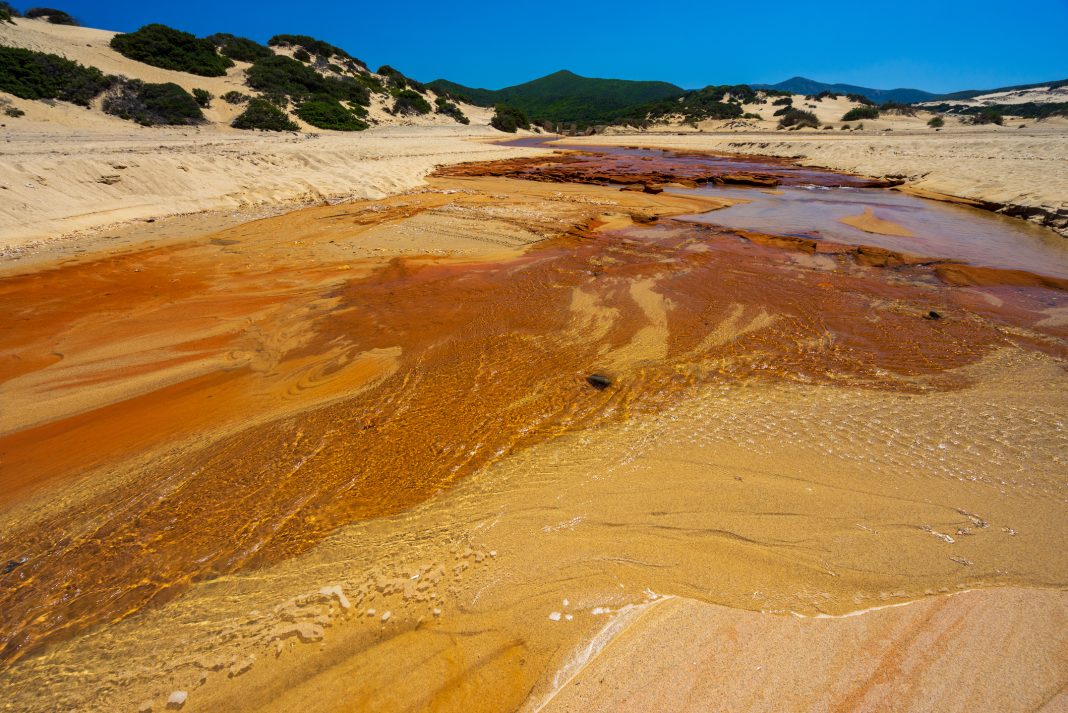This review explores how Cadmium (Cd), a toxic heavy metal that continues to pollute our environment, impacts plants and humans, and examines how plant growth-promoting bacteria (PGPB) can be used for eco-friendly remediation through multi-omics approaches
1.1) Definition
Heavy metals are defined as elements that are denser and heavier than water. Heavy metal pollution is caused by socioeconomic and industrial activities, and is considered one of the biggest environmental problems (Khalef et al., 2022; Ali et al., 2019). Another definition of heavy metal is a naturally occurring chemical element in water, soils, and rock, with a density of more than 5 g/cm3 (Nyika & Dinka, 2023).
1.2) Source of heavy metals
It is believed that sedimentary and igneous rocks are the most prevalent natural sources of heavy metals. The proportions of elements that are present in one form of rock differ from those in another, as well as from one type of rock to another (Ijaz et al., 2024). Anthropogenic sources of heavy metals include mining, wastewater, agriculture, and industries. These sources such as smelting, which release heavy metals into the environment.
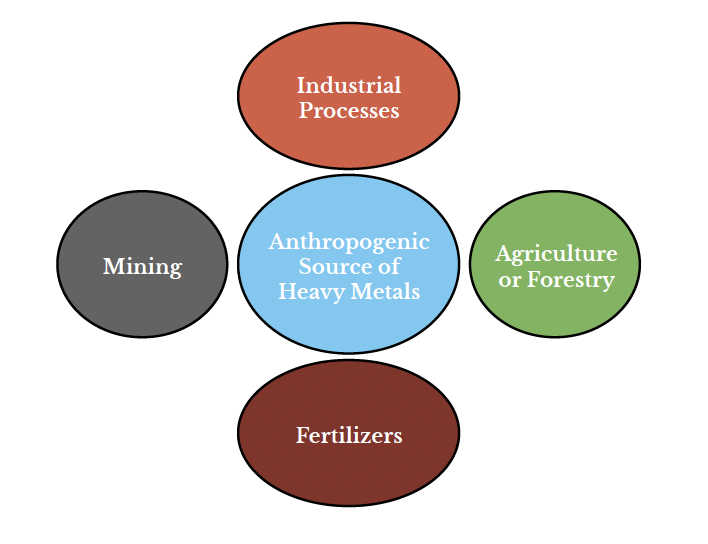
Moreover, routine human activities like farming, manufacturing, use of fertilizers and industrial processes harm the biosphere’s equilibrium (Gok et al., 2024).
1.3) Toxicity of Cadmium (Cd)
The International Agency for Research on Cancer (IARC) has designated cadmium as a carcinogen. It is a phytotoxic heavy metal (HM) that has a high water solubility, which causes it to bio-accumulate in the food chain (Dutta et al., 2020). According to Dobhal et al. (2025), it is a transition element with an atomic number of 48, a boiling point of 765 °C, a relative melting point of 321 °C, and an atomic mass of 112.14. El Rasafi et al. (2022), has documented issues related to Cd in plants, including chlorosis, fluctuation in antioxidant enzymes, leaf epinasty, lipid peroxidation, inhibition of pollen generation and tube development, and reduced photosynthesis. From a toxicological perspective, Cd is a substance that should be avoided because exposure to it harms living things both immediately and over time. Both the earth’s crust and ocean water naturally contain cadmium (Grobelak et al., 2019). In oceanic waters, llevels of Cd (0.11 mg/L) have been linked to kidney and prostate cancers, but average levels in terrestrial habitats range from 0.1 to 0.2 mg/kg (Singh et al., 2020). Cd toxicity can lead to lung, kidney, and bone problems (Fatima et al., 2019). According to Wasana et al. (2017), the WHO considers 0.003 mg/L of Cd in drinking water to be an acceptable limit.
1.4) Effect of Cd on Human Health
It has been noted that contaminated environments annually affect approximately 600 million people (Njoga et al., 2021). Polluted agricultural regions pose a serious problem worldwide due to Cadmium contamination (Tomza-Marciniak et al., 2019). As Cd is a toxic, stimulating and carcinogenic element, its role has been widely investigated recently (Ali et al., 2020). In the human body, Cd biological half-life ranges from 16 to 30 years (Coleman et al., 2017). Due to Cd contamination, it has been noticed that high blood pressure and some chronic lung diseases (asthma, bronchitis) are related. Cancer, genetic toxicity and leukemia can be caused by long-term exposure to Cd (Rafieeradetal.,2025). Within 15-30 minutes, abdominal pain, burning, vomiting, nausea, salivation, muscle cramps, and dizziness can be caused by acute ingestion. Cd contamination plays a significant role in causing chronic diseases, such as osteomalacia of the vertebral bodies, femurs, and pelvic bones (Ciosek et al., 2023).
1.5) Effect of Cd on plants
Cd levels in agricultural soil should not exceed 100 mg/kg (Wang et al., 2019). Under the high concentration of Cd, root tip browning, growth inhibition, and chlorosis of plants are common signs (Fu et al., 2021). Due to the Cd toxicity, the shortage of Fe (II) occurred, which ultimately affects the process of photosynthesis. It has generally been demonstrated that Cd hinders plants’ ability to absorb, move, and use water and a number of elements (Ca, Mg, P, and K). By inhibiting the nitrate reductase activity in the shoots, Cd also decreased nitrate absorption and its movement from roots to shoots (Khatun et al., 2022). During Cd treatments, soybean plant nodules showed a reduction in nitrogen fixation and primary ammonia assimilation (Li et al., 2022). Cd poisoning can reduce the water content by altering the permeability of the plasma membrane. Specifically, the toxicity of Cd leads to water imbalance, as higher levels of Cd cause oxidative stress, which in turn affects carbon assimilation, resulting in plant wilting. In wheat and sunflower, ATPase activity of the root plasma membrane fraction decreases due to Cd contamination (Liu et al., 2023). Cd causes disruptions in chloroplast metabolism by preventing chlorophyll biosynthesis and decreasing the activity of enzymes involved in CO2 fixation, as well as changes in membrane function by causing lipid peroxidation (Saengwilai & Meeinkuirt.,2021). Excessive Cd in wheat (Triticum sp.) decreases shoot and root length, plant nutritional content, and seed germination. On the other hand, Cd buildup decreased shoot growth in garlic (Allium sativum). Similarly, it inhibits root growth and decreases shoot growth in maize (Zea mays) (Chen et al., 2023).
1.6) Different methods used for remediation of Cd
Several methods, including phytoextraction, phytoaccumulation, phytovolatilization, phytostabilization, and phytotransformation, are involved in phytoremediation (Table 1). The mechanisms of phytoaccumulation and phytoextraction cooperate (Sharma et al., 2023). For example, plants absorb heavy metals including chromium (Cr), zinc, nickel (Ni), and cadmium (Cd) as well as other minerals and nutrients from the soil during phytoextraction. The phytoaccumulation system then aids in the accumulation of these components in the shoots and leaves (Nedjimi, 2021). Numerous plant species with a high capacity for accumulation have been documented in the past; they could be suitable candidates for phytoremediation.
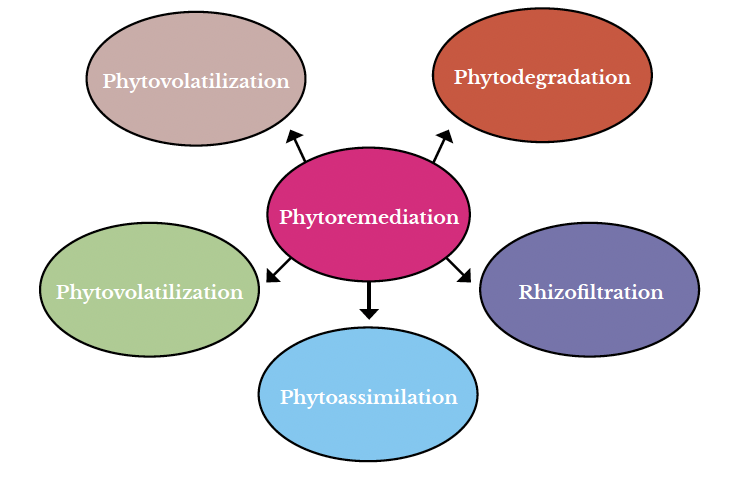
1.7) Role of Microbes for phytoremediation of Cd
Various microorganisms enhanced the process of phytoremediation by separating and adsorbing Cd (Raklami et al., 2022). And by the production of different compounds such as organic acids, polymeric substances, biosorption, and bioaccumulation by microbes for the remediation of Cd (Priya et al., 2023). Siderophores are involved in the remediation of Cadmium; these are low-molecular-weight iron chelators (Kumar et al., 2023). The bioavailability of Cd is increased by the organic acids produced by the soil bacteria. These acids are important for the remediation of the (Qiao et al., 2022). Most microbes produced extracellular polymeric molecules such as exopolysaccharides (EPS), which decrease the bioavailability and mobility of Cd in the soil (Zainab et al., 2024). Biosorption and bioaccumulation are other types of microbially-assisted phytoremediation, where plants absorb Cd with the help of soil heavy metal-tolerant microbial strains, and these tolerant strains increase the growth of the plants (Nnaji et al., 2023).

1.8) Effect of plant growth promoting bacteria (PGPB) on remediation of Cd
For the phytoremediation of Cd, various researchers have demonstrated the function of the PGPB. (Mukherjee et al., 2024; Gupta et al., 2024). Arthrobacter is involved in the remediation of Cd from soil by inoculating on the Ocimum gratissimum (Tennakoon et al., 2025). In a similar manner, Glycine max was infected with Arthrobacter sp. in soil contaminated with Cd. The bioavailability of Cd to the plant was significantly increased by the application of Arthrobacter sp.( Nedjimi,2021). A Cd-tolerant PGRB called Bradyrhizobium sp. lowers Cd toxicity and enhances the agronomic characteristics of plants cultivated in soil contaminated with Cd. Bradyrhizobium sp. was inoculated on Lolium multiflorum, which caused the soil to absorb Cd and raised biomass. Additionally, the induction of Cd accumulation was noted in Lolium multiflorum shoots (Latif et al., 2025). An Astragalus sinicus plant was inoculated with Mesorhizobium huakuii subsp. rengei B3. The cell-mediated Cd binding capability increased by 19 times, according to the data. Bacillus altitudinis SrN9 and Arthrobacter sp. SrN1 were used in rapeseed to lessen the harmful effects of Cd (Yang et al., 2024). Similarly, after being inoculated with the bacterial strain Rhodococcus erythropolis NSX2, the roots of the Sedum plumbizincicolaa plant showed increased Cd uptake (Du et al., 2022). Use of PGPB to remediate the soil from Cd stress is one of the eco-friendly and cost-effective methods. On the surface of the bacterial cell, different kinds of functional groups are present, which are involved in the remediation of Cd (Wu et al., 2022).
Previously, it was reported that Bacillus subtilis, Pseudomonas aeruginosa, and Saccharomyces cerevisiae are the best strains for remediation (Zulfiqar et al., 2023). It was noticed that Bacillus subtilis absorbed Cd from soil was 75.76 and 69.56% as compared to the control (Elnahas et al., 2021). Bacillus subtilis increased the water absorption and decreased the electrolyte leakage to reduce the toxicity of the Cd and promote the growth of the plant (Yao et al., 2021). Similarly, under Cd-contaminated soil conditions, Bacillus licheniformis increased the accumulation of Cd in plants and reduced the harmful effects of Cd (Zeng et al., 2024). In literature, it was also found that inoculation of Bacillus siamensis on wheat (Triticum aestivum) reduced the Cd effects by producing super oxidase (SOD) and catalase enzyme (CAT) (Liu et al., 2024). Under Cd stress, it was also observed that this strain can increase amino acid synthesis, total soluble sugar content, and membrane integrity of plants (by increasing the production of anti-oxidative enzymes such as catalase, peroxidase, which decrease the reactive oxygen species produced during stress conditions, which damages the cell membrane) (Latif et al., 2025). Furthermore, bacterial-assisted Cd bioremediation may benefit significantly from the use of plant growth-promoting rhizo-bacteria (PGPR) (Ajmal et al., 2022). PGPR inoculants, including Rhodococcus sp. 4N-4, Flavobacterium sp. 5P-4, Variovorax paradoxus 2C-1, Flavobacterium sp., Kluyvera ascorbata SUD165 and SUD165/26, Pseudomonas tolaasii RP23, P. fluorescens RS9, Rhodococcus sp., Variovorax paradoxus, Pseudomonas aeruginosa, Pseudomonas sp., Bradyrhizobium sp., Ochrobactrum cytisi, Bacillus megaterium, and Rhodobacter sphaeroides have been used extensively to reduce the toxicity of Cd in a variety of agricultural and horticultural crops cultivated in soils contaminated with Cd (Zhou et al., 2021; Pishchik et al., 2021; Kumar et al., 2023). To protect plants from the toxic effects of Cd, PGPR also mobilize metal from the soil, especially phosphates, and produce antifungal compounds, such as hydrogen cyanide, 1-aminocyclopropane-1-carboxylate (ACC) deaminase, which is released by certain PGPR, aiding in plant recovery from biotic and abiotic stress (Fu et al., 2022). As a result, PGPR may be applied in phytoremediation methods and can enhance a species’ ability to eliminate Cd through bioremediation ( Jabeen et al., 2022).
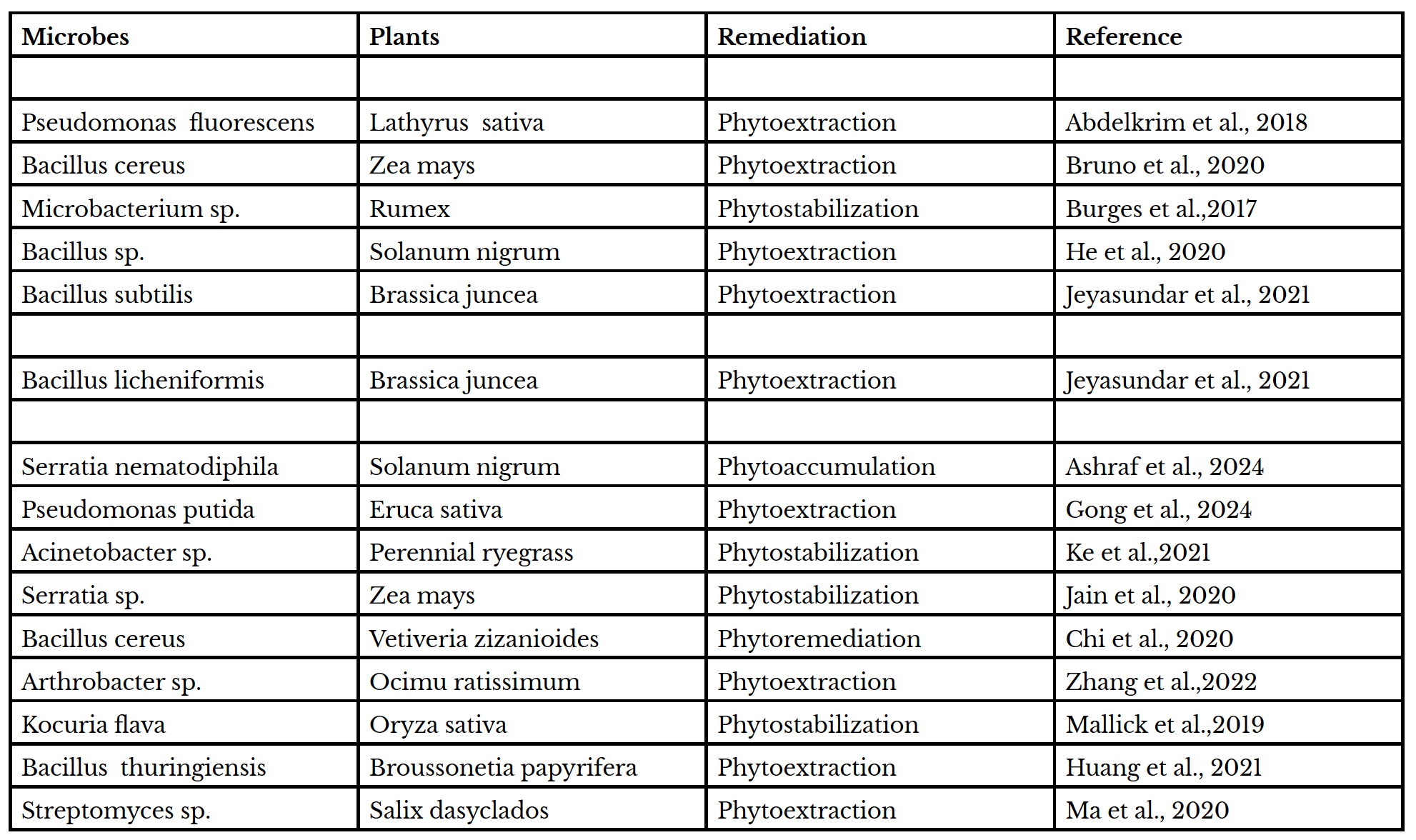
1.9) Activity of PGPB in Cd contaminated soil
Plant growth and activity depend on the microbiome, and PGPB, in particular, regulates plant growth through the production of phytohormones, plant nutrient uptake, and the reduction of both biotic and abiotic stress (Munir et al., 2022). These mechanisms enable plants to tolerate high concentrations of Cd, thereby enhancing their survival in harsh environments. Under Cd stress, PGPB may either directly or indirectly stimulate plant growth. By producing phytohormones (such as auxin, cytokinin, gibberellin, abscisic acid, and ethylene) or promoting the uptake of plant nutrients (such as nitrogen, phosphate, and potassium) (Orozco-Mosqueda et al., 2023). The growths of antibacterial chemicals indirectly promote plant growth because the interaction between PGPB’s antibacterial activity and nutrient competition reduces the growth of pathogenic bacteria (Ajijah et al., 2023). A particular PGPB may employ one or more of these methods to increase plant resilience to environmental stressors. Coordinate, chelate, and ion exchange are additional ways that PGPB can adsorb metals. By altering the metal bioavailability through mobilization, transformation and stabilization under Cd stress, PGPB increased the efficiency of the bioremediation (Saeed et al., 2021). The efficiency of the phytoremediation depends on the biomass of plants remediated and the bioavailability of the soil microbes.
For the growth of plants, minerals such as nitrogen, potassium, and phosphorus are essential. However, under Cd stress conditions, these minerals are not absorbed by the plant (Rashid et al., 2023). Various physiological and biochemical processes in the tissues of the plants are affected by the harmful effects of Cd, which in turn cause effects to the organelles of the plants, such as reduction of biomass, chlorophyll content, and photosynthesis rate, etc (Zhao et al., 2021). According to several studies, PGPB plays a significant role in the synthesis of phytohormones, which regulate physiological processes, normal development, plant growth, and responses to both biological and non-biological stress (Farhat et al., 2022; Waheed et al., 2022). By controlling the expression of transport genes for Cd, Pseudomonas fluorescens enhanced the growth of Sedum alfredii under extreme Cd stress conditions (Hussain et al., 2022). The ability of B. subtilis, which produces abscisic acid (ABA), to reduce Cd accumulation in Arabidopsis thaliana was shown by Meng et al. (2022). Certain bacteria have the ability to increase the production of peroxidases, catalases, and proteases in plants (these are the enzymes produced by the plants for an effective defense mechanism, but due to extreme stress conditions, their production decreases). Under stress conditions, oxidative stress is induced, resulting in the production of reactive oxygen species that decrease normal enzyme activity. HM-tolerant strains can decrease oxidative stress by influencing the plant hormones such as salicylic acid, auxins, and cytokines, which act as signaling molecules that enhance the production of peroxidases, catalases, and proteases (Wang et al., 2023). Additionally, plants that have PGPB with ACCD can reduce their ethylene levels and increase their resistance to climatic stress by cleaving the synthesis of ethylene precursor 1-aminocyclopropane-1-carboxylate and metabolizing it into α-butanone acid and ammonia (Blake et al., 2021).
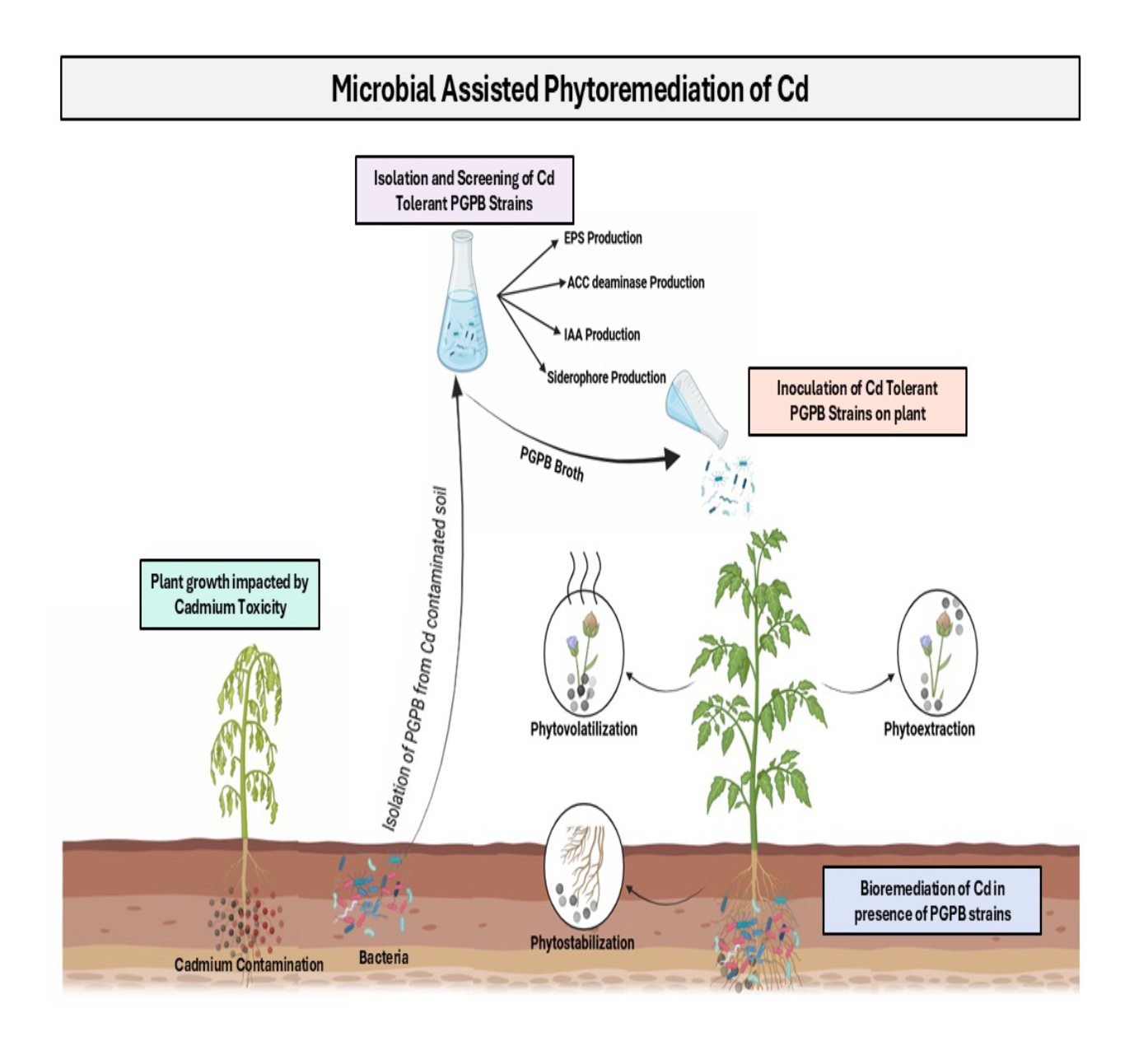
1.10) Improvement of heavy stress by PGPR
PGPR may tolerate heavy metal stress and also reduce the detrimental impacts of heavy metals on plant development (Zainab et al., 2020). In general, PGPRs are considered a specific type of bacteria that can have a significant impact on growth and activity. Plant growth-promoting rhizobacteria stimulate plant development by:
- Supplying nitrogen, phosphorus, potassium, and iron to their host plants.
- Producing Indole Acetic Production (IAA) and ACC-deaminase (1-aminocyclopropane-1- carboxylate-deaminase enzyme) (which decreases high level of ethylene produced by the plant under stress conditions).
- It serves as an agent for biocontrol.
- Increase exopolysaccharide synthesis
By acting as chemical species and converting surface metal bio sorption into lethal forms, PGPR can protect their host plant from the harmful effects of heavy metals. As a result, rhizobacteria that promote plant growth are used to remediate contaminated soil (Ke et al., 2021).
2) Omics Approaches for Bioremediation
The use of omics techniques such as transcriptomics, metagenomics, metabolomics, etc., has gained a lot of attention in environmental management, particularly in the bioremediation process for Cd detoxification (Lata et al., 2023). These methods facilitate learning about the mechanics of microorganisms that inhabit a specific niche, as well as various perspectives on bioremediation. By accelerating the research process, these technologies are taking the place of culture technology to organize the microbiome (Kumar & Thakur, 2022).
2.1) Metagenomics
Since metagenomics is relatively independent of culture techniques, it has been shown to be a powerful and practical approach to identifying novel micro-communities that combat environmental contamination problems. By analyzing the DNA sequences of these microorganisms that are thriving in the environment, metagenomics provides novel data about remediation technologies (Wani et al., 2022). Metagenomics was originally used by Singh et al. (2021). This method enhances the likelihood of discovering distinct genes and their various pathways, which aids researchers in combining genomic culture-based studies (once the distinct genes or pathways are discovered, researchers can make a primer set to identify those genes in isolated strains in the laboratory). Accordingly, studies on Cd pollution can be carried out more successfully and new biomolecules investigated by combining molecular techniques and software tools (Patil & Sarkar,2022). Microbes’ bioactive compounds and enzymes, as determined by metagenomics approaches, play a significant role in the remediation of polluted environments (Chettri et al., 2024). Among the significant microbial taxa that may endure in Cd environments are Bacteroidetes, Chloroflexi, Proteobacteria, Firmicutes, Actinobacteria, and Spirochetes (Dwivedi et al., 2023). Furthermore, the vast array of microbes can be sequenced from a new place; most metagenomics researchers are interested in pyrosequencing. Previously, 1736 genera and 77 distinct phyla were identified in metagenomic sequences, enabling researchers to assign sequences at the taxonomic level, including phylum, class, order, family, genus, and species (Zhang et al., 2021). The most prevalent phyla in the samples were Proteobacteria, Gemmatimonadetes, Thaumarchaeota, and Acidobacteria, which accounted for over 75% of the total population in each sample. According to the findings, Cd contamination may have the ability to alter the microbial composition of soil and reduce the taxonomic species of microorganisms present (Miglani et al., 2022). Additionally, it was discovered that variations in microbial structure led to changes in the functional pathways engaged in the soil, many of which were connected to the soil microorganisms’ ability to withstand heavy metals. These results demonstrated that Cd-contaminated soil might be used to investigate bacteria that are tolerant or resistant to Cd.
2.2) Transcriptomics
Transcriptome sequencing provides precise digital signals for researching how cell metabolism is regulated under specified physiological conditions, and it facilitates the collection of all transcription products (mRNA) (Magar et al., 2022). RNA-Seq technology is used to classify how bacteria enhance Cd tolerance. In bacteria, there are different genes argH, argF, hutU, hutH, lpdA, and acnA, which may be involved in the production of citric acid metabolism under higher concentrations of Cd (Fishman et al., 2024). Bacteria reduce the toxicity effect of Cd by expressing the genes linked to the induction of mineralisation and overcome the effect caused by the higher concentration of Cd. Under the extreme condition of Cd, this is the distinct fundamental bioremediation method to remediate the soil by using the microbes.
2.3) Proteomics
In order to understand how organisms react to their surroundings, large-scale protein data known as proteomics can be used (Sanches et al., 2024).
Under Cd stress conditions, most of the proteins were destroyed. Plant response to the Cd stress by the production and expression of genes, proteins, amino acids and signal molecules (Satrio et al., 2024). The plant’s roots are generally more exposed to the Cd effect according to the proteomics. In response to Cd stress, proteins present in wheat roots are linked to protein metabolism, DNA repair and replication, as well as the glutathione metabolic pathway (González-Plaza et al., 2022). Microbes that control the penetration of Cd in plant roots can also regulate the expression of proteins in these roots (Khanna et al., 2022). According to Wu et al. (2022), hybrid Pennisetum leaves treated with Cd in the presence of Bacillus megaterium 1Y31 showed increased expression of proteins linked to photosynthesis and energy generation. It has been discovered that Enterobacter bugandensis TJ6, a Cd-immobilizing bacterium, greatly reduces the uptake of Cd by wheat grains and enhances the diversity of bacterial communities in wheat rhizosphere soil (Zhao et al., 2022). However, nothing is known about the proteome analysis of wheat treated with Cd in conjunction with E. bugandensis TJ6.
3) Conclusion
One potential technique for cleaning up Cd-contaminated soils is microbial-assisted phytoremediation. Despite its fundamental appeal, this method is a sluggish and ineffective procedure that frequently leads to insufficient treatment. Microbes have been employed to improve phytoremediation in order to get around these restrictions. There are several methods that soil bacteria might break down pollutants. Inoculation with certain degrading bacteria, plant growth-promoting rhizobacteria, and mycorrhizal and endophytic fungi can be employed to increase the Cd remediation impact based on employing solely plants. Additionally, bacteria respond to higher concentrations of Cd and reduce its toxicity by the expression of certain genes. Understanding the principles of microbe-assisted phytoremediation of Cd and identifying microorganisms that can treat diverse contaminants in various environments are prerequisites for the effective application of these combined techniques, which can be used for sustainable agricultural practices and protect the environment from the harmful effects of Cd.

